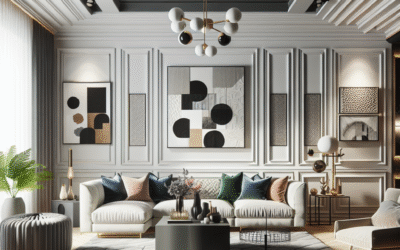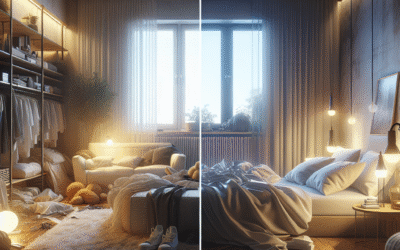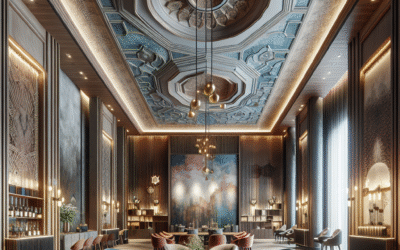
10 Ways to Scandinavian Design Inspiration to Create Calm Spaces
Scandinavian design inspiration is the key to crafting calm spaces that promote relaxation and clarity. This article reveals 10 practical ways to bring those serene vibes into your home or office, helping you reduce stress and enjoy peaceful environments.
Have you ever walked into a space that immediately calmed your mind and made you feel at ease? Often, that peaceful feeling is rooted in good design—specifically Scandinavian design. Known for its simplicity, functionality, and natural elements, Scandinavian design inspiration offers powerful tools for anyone looking to create calm spaces.
In this guide, you’ll uncover ten actionable ways to infuse your interiors with this style’s serenity. From choosing the right colors to embracing minimalist decor, these methods focus on improving wellbeing through environment. Along the way, you’ll find expert insights, real-world examples, and practical strategies that anyone can apply.
We’ll explore:
- The calming color schemes behind Scandinavian interiors
- How natural materials transform atmosphere
- Furniture choices that foster peace and function
- Lighting techniques for airy, restful rooms
- Incorporating greenery for stress relief
- Easy decluttering hacks inspired by Nordic simplicity
- Textile options that soothe and warm spaces
- Styling tips to maintain minimalism without coldness
- The psychology of space and Scandinavian balance
- Tools and resources for DIY calm space design
Ready to turn your space into a haven of calm, inspired by Scandinavian design? Let’s begin.
1. Embrace Soft, Neutral Color Palettes for Serenity
Color shapes mood faster than any other element. Scandinavian design inspiration prioritizes soft neutral tones—think whites, light grays, beiges, and muted pastels. These colors expand space, reduce visual noise, and foster calmness.
Why Neutral Colors Work for Calm Spaces
Neutrals minimize overstimulation and create a blank canvas that allows your mind to settle. Research from color psychology confirms that soft colors like pale blue or warm beige lower heart rate and encourage relaxation.
How to Apply Soft Colors Effectively
- Walls and Ceilings: Use crisp white or soft gray paint for maximum light reflection.
- Furniture and Accessories: Incorporate these tones through upholstery, rugs, and curtains for seamless cohesion.
- Accent Shades: Add subtle pastel accents—like dusty pink or sage—to avoid monotony.
Practical tip: Test small paint samples and view them in different lighting before committing. Scandinavian rooms often benefit from daylight-mimicking bulbs that enhance these hues.
2. Incorporate Natural Materials to Connect with Nature’s Calm
Wood, stone, and natural fibers are foundations of Scandinavian design inspiration. These materials bring texture and warmth, subtly anchoring our senses in nature’s tranquility.
Wood: The Heart of Nordic Interiors
Light woods, such as pine and birch, enhance the sense of spaciousness while adding a warm organic feel. Unfinished or matte surfaces create understated elegance and tactile comfort.
Stone and Other Elements
Elements like stone countertops or ceramic vases introduce grounding textures without overwhelming the space. Pairing these with wood balances cool and warm tones beautifully.
Natural Fibers in Textiles and Décor
Linen curtains, wool throws, and jute rugs all contribute layers of softness and calm. They not only add visual interest but also improve acoustic comfort by dampening noise.
Pro tip: When selecting materials, prioritize sustainable sources for an eco-friendly, calming impact that aligns with Nordic values.
3. Choose Functional Furniture With Clean, Simple Lines
Scandinavian design inspiration emphasizes functionality without excess. The furniture usually has clean, geometric lines and multi-purpose uses, which bring order and tranquility.
Minimalism Meets Comfort in Seating
Select sofas and chairs that blend minimalist shapes with comfortable cushions. Swedes masterfully combine durability with cozy aesthetics, inviting relaxation.
Storage That Supports Calm
Clutter breeds anxiety. Functional storage units—think open shelving, built-ins with doors, or sleek sideboards—help maintain visual calm. Choose pieces that hide mess without sacrificing style.
Multi-Use Furniture Ideas
Consider foldable tables, nesting side tables, and ottomans with storage. These not only save space but bolster the serene ambiance by reducing visual clutter.
| Feature | Traditional Furniture | Scandinavian-Inspired Furniture |
|---|---|---|
| Lines | Ornate, complex | Simple, clean |
| Materials | Heavy, dark wood | Light wood, natural fibers |
| Function | Single purpose | Multi-functional |
| Visual Effect | Busy, heavy | Airy, calm |
4. Optimize Lighting to Enhance Calm, Airy Ambiance
Lighting affects mood more than most realize. Scandinavian interior design masters brightness balance — letting in as much natural light as possible combined with warm, layered artificial lighting.
Harness Natural Daylight
Maximize window space and avoid heavy curtains. Use sheer fabrics or blinds that diffuse rather than block light. This connection to daylight maintains energy balance and mental clarity.
Layered Artificial Lighting
Combine ambient (overhead), task (reading lamps), and accent lighting (spotlights) to mimic daylight cycles and reduce eye strain. Choose bulbs with warm white tones (2700-3000K) to create a cozy feel.
Use Reflective Surfaces
Mirrors, light-colored walls, and even light wood surfaces bounce light around, making the room feel larger and calming.
Implementation tip: Install dimmers to tailor lighting to time of day and mood. A softly lit room fosters deep relaxation in the evenings.
5. Add Indoor Plants to Knit Nature Into Your Calm Space
Bringing greenery indoors is a simple yet powerful Scandinavian design inspiration. Plants clean air, increase humidity, and trigger feelings of peace and vitality.
Best Plants for Calm Spaces
- Snake Plant: Requires minimal care and filters toxins.
- Peace Lily: Adds soft blooms and soothes the eye.
- Fiddle Leaf Fig: Statement piece with broad leaves.
- Succulents: Easy to maintain, perfect for minimalist shelves.
Placement Tips
Group plants in clusters to create mini green zones. Position by windows for natural growth cycles. Use simple ceramic or concrete pots aligned with Nordic simplicity.
6. Declutter Mindfully for Visual and Mental Clarity
Clutter overloads the senses and disrupts calm. Scandinavian design inspiration prizes clear, open spaces that foster relaxation and focus.
Decluttering Steps
- Sort: Keep only what you truly need or love.
- Organize: Assign everything a specific spot.
- Store: Use closed storage to hide items while preserving accessibility.
Maintain the Serenity
Regularly check decor and personal items to avoid creeping clutter. Minimalist decorations that serve double duty keep surfaces clean.
Tip: Scandinavian homes often embrace “less is more” with intentional placement of a few meaningful objects rather than many.
7. Use Textiles Wisely to Add Warmth Without Chaos
Textiles soften spaces visually and physically. Scandinavian design inspiration uses natural fibers in muted tones to cozy up cold minimalist lines.
Recommended Textures
- Wool Throws: Thick, warm, and inviting.
- Linen Cushions: Lightweight and breathable.
- Cotton Rugs: Durable with subtle patterns.
Layering Techniques
Layer rugs or blankets to create depth and tactile comfort. Stick to a complementary color scheme to keep cohesion and calmness.
8. Balance Minimalism with Inviting Details
Scandinavian design inspiration can sometimes feel stark, but the true magic lies in softening minimalism with curated decorative touches.
Inviting Details
- Handcrafted ceramics or pottery with matte finishes.
- Simple art pieces with nature motifs.
- Warm candlelight and subtle scents like pine or lavender.
Keep It Intentional
Avoid overcrowding surfaces. Let each piece “breathe” to maintain room flow and peace.
9. Understand the Psychology Behind Scandinavian Calm Spaces
A calm space lowers stress hormones and encourages mindfulness. Scandinavian design inspiration appeals to our innate biophilia—our connection to nature and natural rhythms.
Research Insights
Studies from environmental psychology show that minimal, nature-inspired interiors reduce cortisol levels and improve focus. This means less anxiety and more productivity.
Applying Psychology to Your Space
Choose designs that promote symmetry, natural light, and sensory comfort. Scandinavian interiors do this with quiet effectiveness, enhancing emotional wellbeing daily.
10. Utilize Technology and Tools for Scandinavian Calm Space Design
Modern tools help bring Scandinavian design inspiration into your space with precision and ease.
Design Software Recommendations
- SketchUp – Intuitive 3D modeling to visualize layouts.
- Roomstyler – Quick interface for experimenting with color palettes and furniture.
- Canva – Craft mood boards to plan your calm space aesthetic.
Helpful Apps for Mindful Arrangements
Use apps like Feng Shui Compass or Houzz for inspiration and placing items in harmony with spatial flow.
Additionally, consider tools like dimmable smart lighting systems (e.g., Philips Hue) to fine-tune ambiance dynamically for relaxation.
Frequently Asked Questions
What is Scandinavian design inspiration?
Scandinavian design inspiration is a style rooted in Nordic culture emphasizing simplicity, natural materials, and functionality to create calm, light-filled spaces.
How can Scandinavian design help reduce stress at home?
This style promotes minimal clutter, natural light, and soft colors, which collectively create soothing environments that lower stress and improve mental wellbeing.
What colors are typical in Scandinavian interiors?
Typical colors include whites, pale grays, muted blues, and soft pastels, all of which maximize light and encourage a tranquil atmosphere.
Are natural materials important in Scandinavian design?
Yes, materials like light wood, wool, linen, and stone deepen the connection to nature and introduce textures that calm and warm spaces.
How do I keep Scandinavian design from feeling cold?
Add warm textiles, plants, and handcrafted decor pieces to balance minimalism with inviting details that nurture comfort and coziness.
Can I mix Scandinavian style with other design styles?
Scandinavian design pairs well with modern, rustic, and mid-century elements, provided you maintain its core values of simplicity and natural balance.
What’s the easiest way to start decorating Scandinavian style?
Begin by decluttering, painting walls in light neutrals, and introducing natural wood furniture and soft textiles.
Conclusion & Next Steps
Scandinavian design inspiration offers a proven blueprint for creating calm spaces that enhance wellbeing and mental clarity. By incorporating soft neutrals, natural materials, clean-lined furniture, thoughtfully layered lighting, and greenery, you set the stage for a soothing environment that serves you daily.
Remember, achieving calm is a process—start small by decluttering or swapping out heavy curtains for light fabrics. Gradually infuse your space with natural textures and functional décor, and observe how your mood shifts.
Ready to take your calm space further? Explore more on minimalist home design tips or dive into using natural light in interiors for a brighter, happier home.
Which Scandinavian design tip will you try first to create your calm space? Share your experience with us or ask questions to keep the conversation going.
Content Disclaimer
Information provided is for educational purposes only and reflects current design insights. Individual results may vary based on personal circumstances and preferences.
Categories
- Accent Walls & Ceilings (61)
- Art Curation & Gallery (62)
- Bedding Style Trends (68)
- Bedroom Makeover (81)
- Bohemian & Eclectic Styles (58)
- DIY & Budget-Friendly Decor (64)
- Eco-Friendly Design (62)
- Furniture Care (71)
- Home Decor & Design Ideas (162)
- Home Wellness Spaces (59)
- Integrated Outdoor Living (67)
- Japandi Style (61)
- Kids and Nursery Decor (59)
- Living Room Decor (79)
- Mix & Match Techniques (73)
- Modern & Contemporary Design (66)
- Rug Sizing & Placement (73)
- Scandinavian Design Inspiration (20)
- Seasonal Home Decor (79)
- Small Space Solutions (73)
- Wall Art & Painting Tips (77)
Recent Comments
Archives
Product Gallery
-
Large Area Green Rugs for Bedroom Nordic Living Room Decoration Shaped Carpet Irregular Plush Lounge Rug Home Thick Washable Mat
Rated 5.00 out of 5$47.00 – $292.00Price range: $47.00 through $292.00 -
Nordic Style Rugs for Bedroom Morandi Living Room Decoration Carpet Large Area Geometry Lounge Rug Home Cloakroom Non-slip Mat
Rated 5.00 out of 5$34.00 – $503.00Price range: $34.00 through $503.00 -
Irregular Shapes Living Room Decoration Carpet Modern Style Rugs for Bedroom Home Thicken Plush Rug Fluffy Soft Lounge Floor Mat
Rated 4.83 out of 5$47.00 – $292.00Price range: $47.00 through $292.00




















